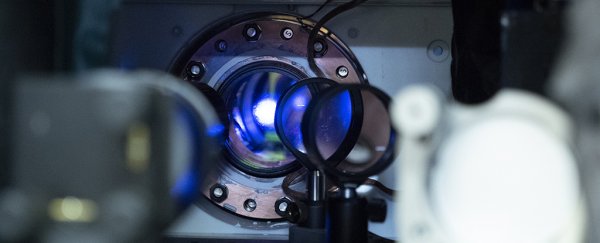In his theory of general relativity, Einstein predicted something called time dilation: the notion that two clocks under two different gravitational pulls will always tick at different speeds.
The effect has been observed in many experiments since, but now scientists have recorded it at the smallest scale seen so far.
The result was achieved using ultra-precise atomic clocks just a millimeter (0.04 inches) apart – about the width of a sharp pencil tip. Collecting 90 hours of data gave the team a reading that was 50 times more precise than any previous similar measurement.
And of course the smaller and more precise the scale, the more we rely on quantum mechanics to explain what's going on. The researchers are hoping that their new readings open up a way to learning more about how the curvature of spacetime – what we experience as gravity – affects the characteristics of particles according to quantum physics.
"The most important and exciting result is that we can potentially connect quantum physics with gravity, for example, probing complex physics when particles are distributed at different locations in the curved space-time," says physicist Jun Ye from the University of Colorado Boulder.
In this experiment, the researchers used what's known as an optical lattice, a web of laser light used to trap atoms in place so they can be observed. It's a technique used for the latest generation of atomic clocks, offering more precision in timekeeping through the laser light waves, and these lattices can be used for quantum simulations too.
Here, the two atomic clock readings were taken from the same cloud of atoms, in a highly controlled energy state. In fact, the atoms ticked between two energy levels in perfect synchronization for 37 seconds, a record in terms of quantum coherence (that is, keeping quantum states stable) – and that stability is essential for these measurements.
That enabled the scientists to take their readings at two separate points, measuring the redshift across the cloud of about 100,000 ultracold strontium atoms. The redshift shows the change in the frequency of the atoms' radiation along the electromagnetic spectrum – or in other words, how quickly the atomic clock is ticking.
While the difference in redshift across this tiny distance was just 0.0000000000000000001 or so, that's in line with predictions made by general relativity. Those differences can make a difference when you get out to the scale of the entire Universe, or even when you're dealing with systems that need to be ultra-accurate, such as GPS navigation.
"This is a completely new ballgame, a new regime where quantum mechanics in curved space-time can be explored," says Ye.
"If we could measure the redshift 10 times even better than this, we will be able to see the atoms' whole matter waves across the curvature of space-time. Being able to measure the time difference on such a minute scale could enable us to discover, for example, that gravity disrupts quantum coherence, which could be at the bottom of why our macroscale world is classical."
Part of what makes this time dilation research so exciting is that it points the way towards atomic clocks that are even more precise in the future, giving scientists a blueprint that can be refined to take measurements on smaller and smaller scales.
Atomic clocks have come a long way in the last few decades, and there's plenty more to come.
The research has been published in Nature.
